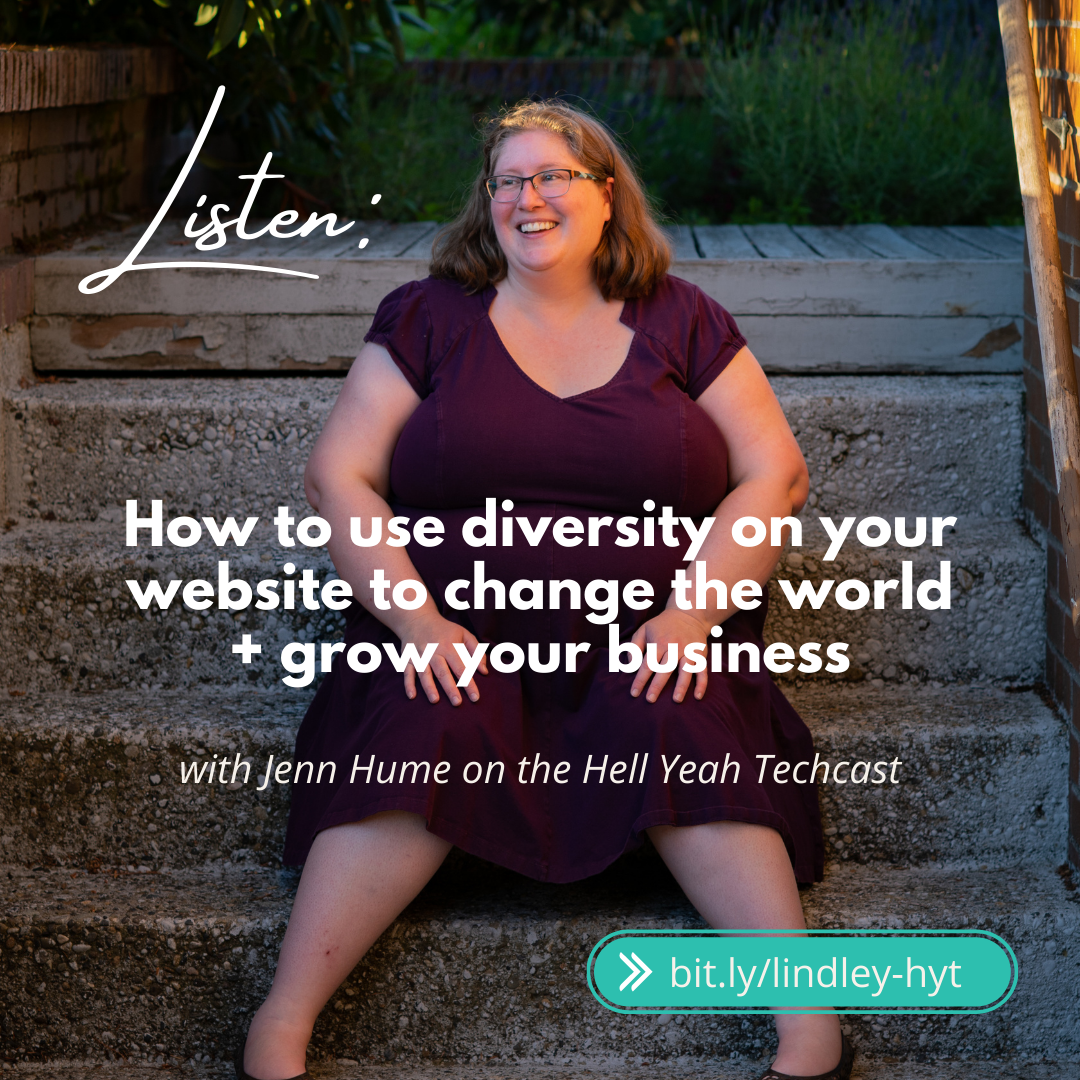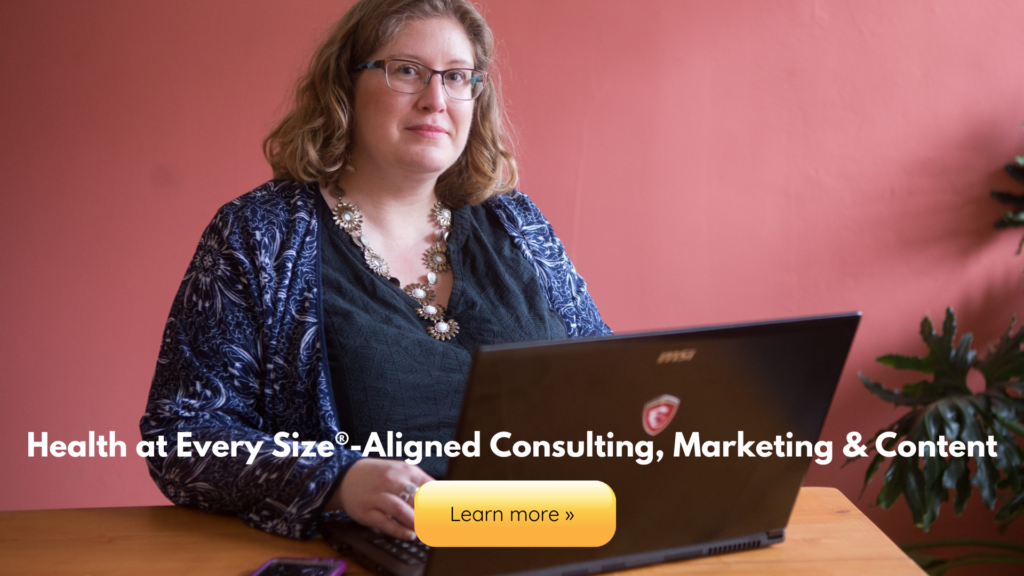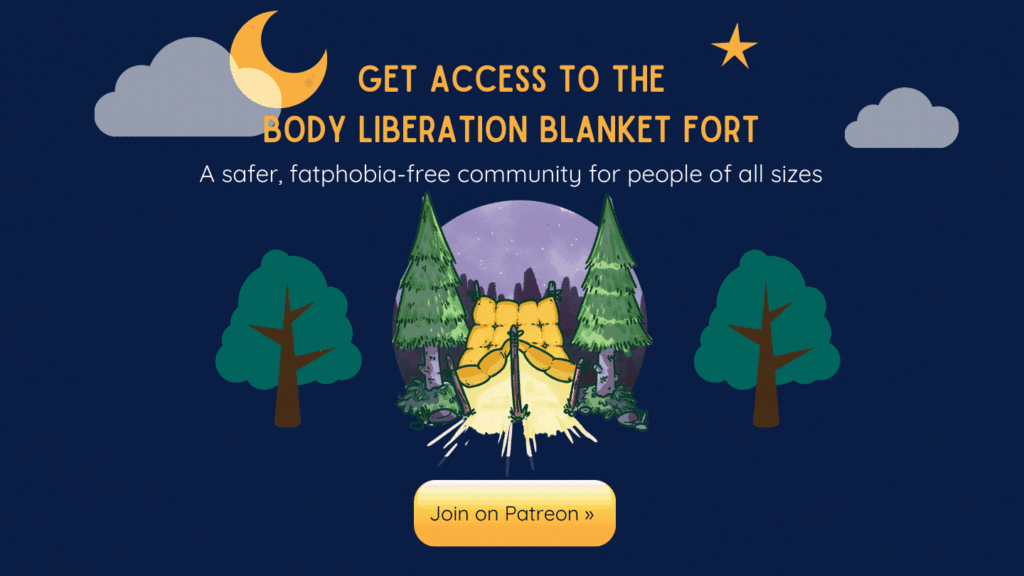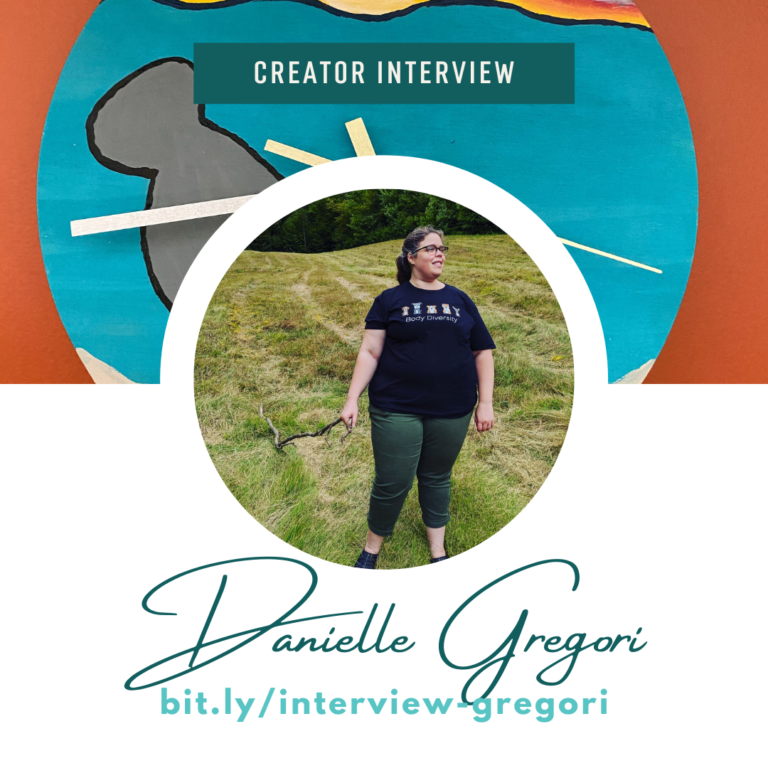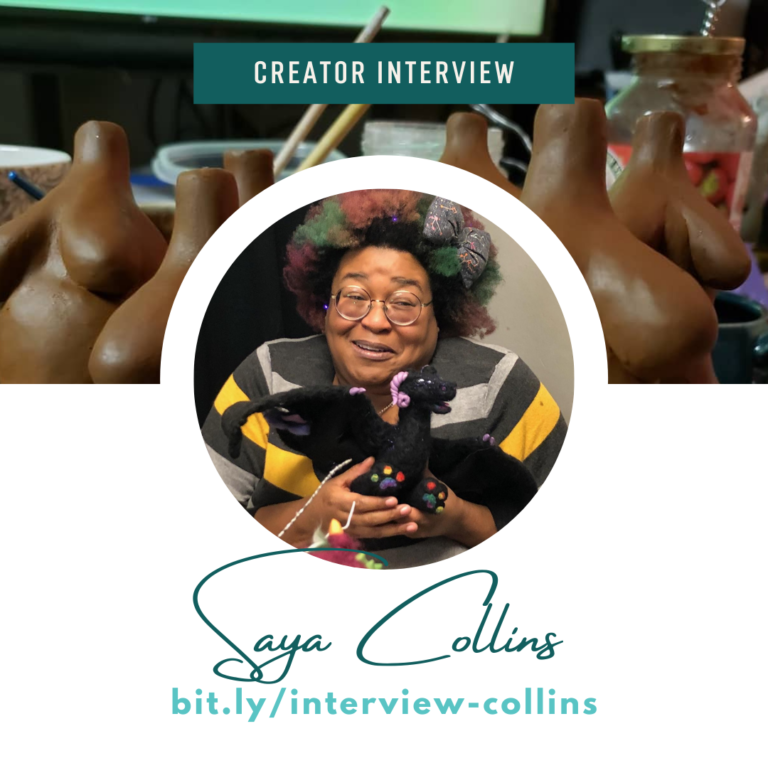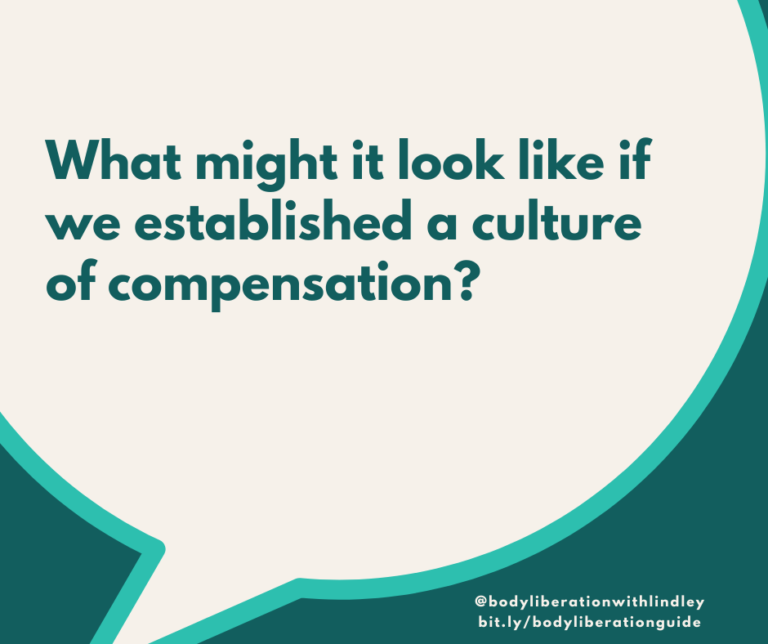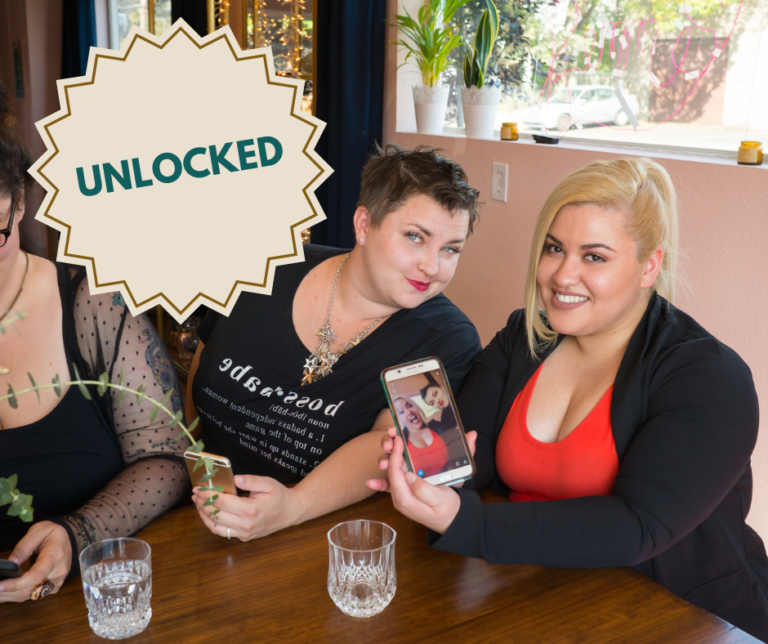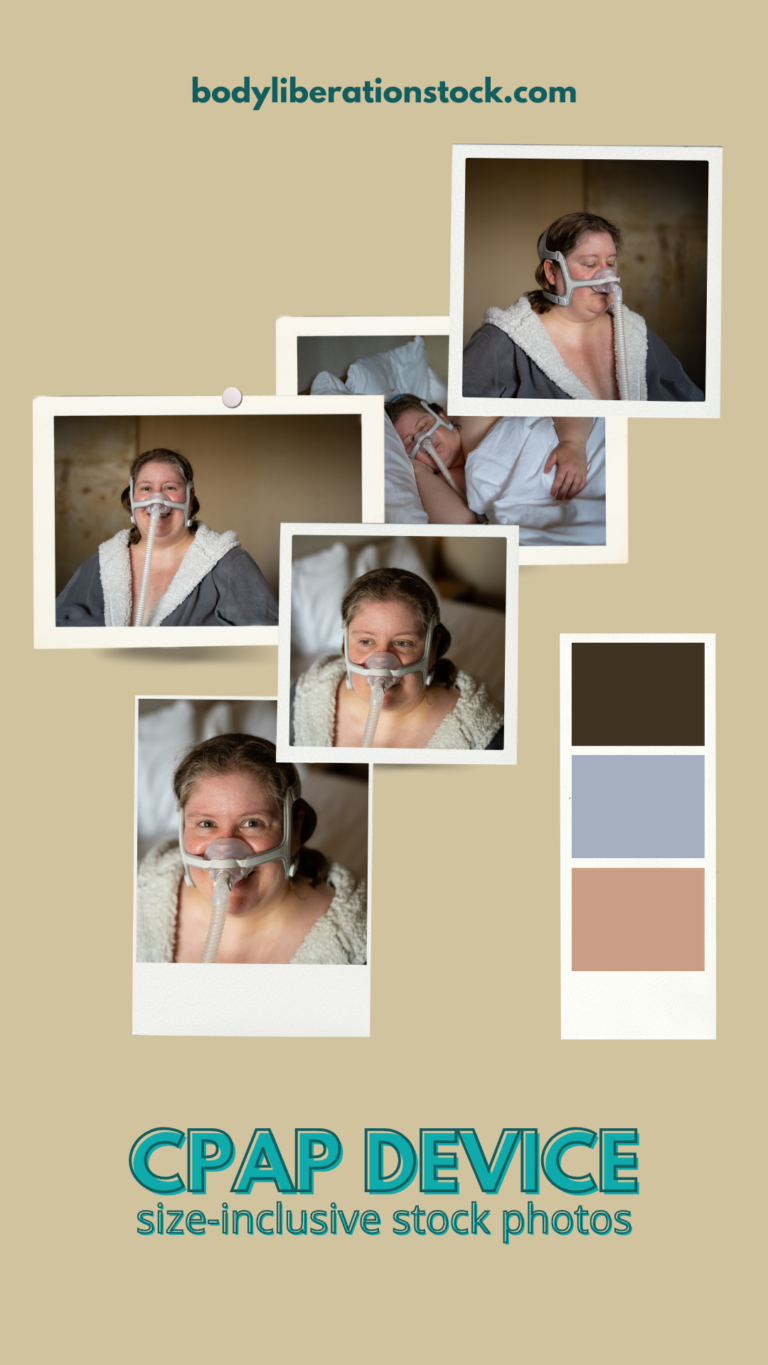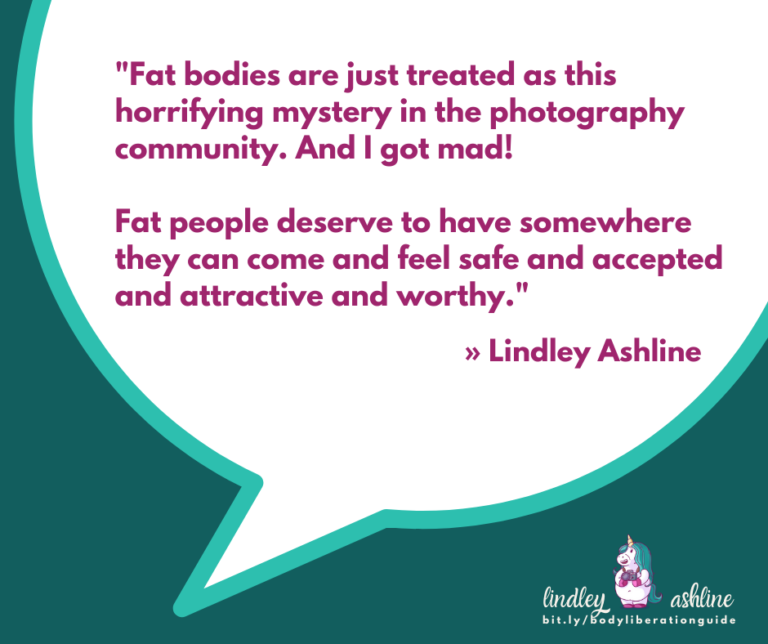Listen: Lindley on the Hell Yeah Techcast with Jenn Hume
Every single time I’m asked to be on a podcast, it’s an honor, but it’s an especially big deal to be the very first guest on an existing podcast! Jenn Hume, owner of Hell Yeah Tech, and I talked on her Hell Yeah Techcast about websites, marketing and inclusive stock photography. Jenn is exactly my kind of geek — funny, quirky, logical and someone you immediately want to be friends with.
In our episode, we talk about:
- How using diverse and inclusive images on your website both helps change people’s body image and helps you grow your business
- Why stock photography isn’t inherently diverse
- How stock photos can perpetuate oppression — or the opposite
- That one stock photo every therapist uses with the field of flowers or river stones
- Using fat-positive and Health at Every Size® SEO to attract customers
- “Pretty” websites and normativity
- Making potential customers and clients feel welcome through your marketing
Listen and read below, and check out Jenn’s tech, process and web services for coaches, consultants and creative types.
Episode Transcript
Jenn: Oh my God. Oh my God. Hello. Hello. This is another Hell Yeah Tech podcast, ramble thing, and I’ve managed to find a victim to come on. She can hear me right now. Actually, Lindley, can you hear me? Can you hear me?
Lindley: I can.
Jenn: Lovely. Okay, cool. I’ve got Lindley Ashline here. And have I pronounced that correctly?
Lindley: Here in the states, we, we say it as Ashline, but I’ll answer whatever.
Jenn: Okay. I’m sorry. I have Lindley Ashline here and Lindley, I love it because she takes all these fantastic photos that are a little bit different, just like a thin white blonde woman laughing at salad on the beach, which we’ve probably had a bit of enough. So and we’ve just been talking about websites and pretty websites and photos on websites, and I’ve forgotten everything we’ve said right now, but it’s mainly, it’s just the photos thing. You know this is something I find like I’m in websites a lot and I see generic photo after generic photo after generic photo. And sometimes when I’m building people’s websites, I’m like, I’ve got all these great women I’m building sites for. I’d love to see something a bit different out there. And it’s where to go for these things, where to get these photos, and so on. So I brought Lindley in who is really into getting more diversity in photos. So, Lindley, it’s over to you, like waffle away.
Lindley: All right. So I’m a photographer writer and activist. I do body image, work, body acceptance work and I’m in the States. I live outside Seattle, Washington, and I primarily do stock photography. And, you know, if you’re building a website, you’re probably familiar with this concept already, but stock photography that’s the photos that people use for their marketing, whether it’s on their website, their social media. And these are photos that people are generally buying from another website. Because most of you don’t have the budget to hire a photographer to do a special photo shoot every time you want a photo.
Yes, and even larger companies aren’t doing that either unless you’re Microsoft or Coca-Cola. So, people are buying stock photos, and to get a little nerdy for a second. Stock photos are both prescriptive and descriptive. So when I talk about them being descriptive the reason is that when you go to the big stock photo sites, Getty, Dreamstime, Dream Stock, all these places. When you go to them, the photos all look the same. And so they are descriptive in that if I am your average mainstream stock photographer, I want to take photos that are going to sell. And so I’m going to work with models. I’m going to use sets. Larger stock companies like Getty. When you see these hospitals… you can’t see me, but I’m making air quotes. When you see these hospitals and these conference rooms and these bank branches and all these professional settings that look naturally clean and new, it’s because those are sets just like TV sets.
I’m told that somewhere here in Seattle, Getty images actually have a studio. It’s like a movie studio where there are sets where they take these photos. And so these are models posing in fake rooms. But that is because… again, photographers are being descriptive in that they are taking photos of what we expect to see because they want to take photos of the most normative and the most socially approved people and places possible so that their photos sell and that’s fair. But on the other hand, stock photography is also prescriptive in that the more we see only a certain type of body or skin color or place represented or gender then that is what we expect to see.
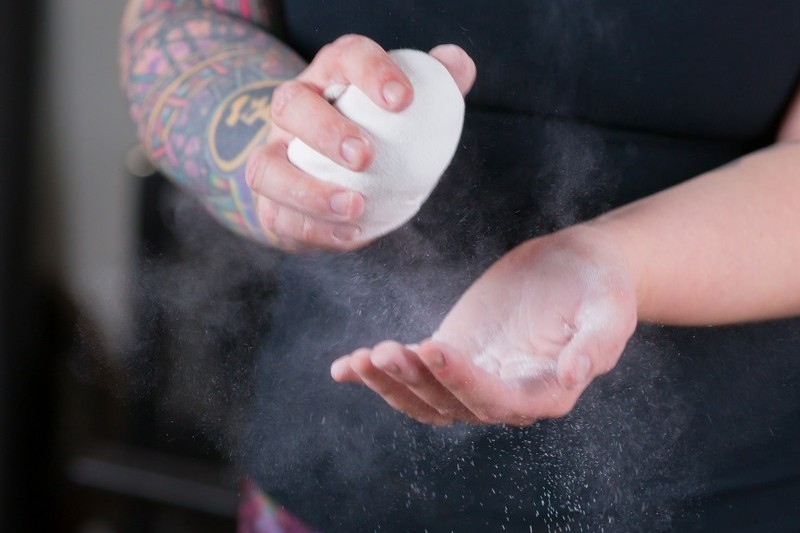
Fitness, Movement & Exercise
Browse photos for inclusive fitness, exercise and joyful movement on Body Liberation Stock, the central resource for body-positive, plus-size and HAES stock images.
And so photography in itself can perpetuate systems of oppression. It can perpetuate beauty standards, it can perpetuate all these things, and it does. And so, using a stock photo that is not of a 22-year-old model posing as a doctor or whatever, using photos that are outside that is really cool because it directly changes the world. And, and I know that that sounds very dramatic and that’s because it is, because by using photos and marketing, that aren’t just these extremely mainstream ones, not only are you attracting new business because you’re representing your actual customers. I don’t know of any business where every single customer is a 22-year-old professional model, maybe if you’re a model agency, but even then your clients are going to be other companies, your clients aren’t your models.
So, nobody has a business that is only, you know, a 22-year-old model. So you’re representing your actual customers and you’re making them feel welcomed. So not only that, but then in a more abstract sense, you’re changing the world because you’re helping change, who gets represented. And the more we normalize bodies outside 22-year-old models that phrase no longer has any meaning for me, by the way. The more we normalize bodies and images that are outside that 22-year-old model the more all of us feel like our bodies are normal.
Jenn: It’s the feeling welcome thing. You know what I was thinking when I was out walking, I’ve been looking for a co-living space recently, once I get back to nomadic, I mean, I’m staying put in my home country just while COVID is a terrible menace. But I was looking for some like co-living. I’m like, well, I’m fat. I use that word absolutely. It’s descriptive just like, hey, I’ve got brown eyes, I’m fat, and that’s fine. There’s no emotion behind it. But I’m looking and I’m like, well, everyone here seems to be like really thin and much younger than me. Am I going to be welcomed there? I don’t know. And I know, one of them I’ve been to and I’m like, absolutely welcomed, but it’s like, I can’t see myself in any of the photos you use. And it’s like, well, how do I know? You know, it puts me off contacting these places. It’s just because it’s like, well, I don’t know if you will welcome me.
Lindley: Yeah, yeah. If I say I’m looking for a gym because I want to exercise more I am also in a fat body. And of course, gyms are notoriously body size focused to spaces. And if I go to the website for your gym and everyone looks like a 22-year-old model, apparently I’m going to just say that at museums today, then I don’t know, I just assume that people who look like that will be welcome and then I won’t be. And so much of this is at the subconscious level too. And as we know, marketing is very much a semi-conscious to subconscious thing. But we really do learn who’s going to be welcomed by the images that are used. You know, if I’m finding gyms that are showing nothing but very thin people I don’t even know if you’re machines are going to support my weight, I don’t have any way of knowing whether I will be accommodated or included.
I want to add to that. We talk specifically about using photos on our websites and photos and marketing, you kind of have to back it up in real life a little bit like, again, and I’m just going to use this example of the gym. If I find your gym and you say on your gym’s website, very specifically that you are inclusive. You work with people of all body sizes and you use really great photos of people in all kinds of different bodies that are exercising, but I walk into your gym in person and everyone looks like a 22-year-old model. So, diversifying in your marketing has to match a commitment in your business. And I’m writing a whole book on this. I’m really passionate about it but it has to match a commitment to inclusion in your actual business. But more often what I’m finding is people who have more inclusive businesses can’t find photos that match that. So that’s why I do what I do. That’s why I’m taking photos of people in very large bodies because I’m the only person on the planet doing that work, literally.
Jenn: Yeah. It’s funny as well. A lot of my clients had like coaches, therapists, and so on. And even then I still want to know, I still want to see larger bodies because I want to know. And I use coaches, therapists a lot, you know, someone to talk to is great. I want to know I’m not going to get prescribed a diet or weight loss thing, or even have that be an issue. I mean, sometimes you talk to people, you say, well, I’ve got this issues with anxiety and whatnot, and they’re like, well, I have sometimes had that, well, maybe if you lost a little bit of weight and it’s like, oh, no, hang on. No, I mean, yeah, I’m not like anti completely losing weight. I would be like, well, in some cases, okay, it might help. There are some cases where having less gravity working less on the body might help the body, but it’s not in every case.
And it’s like exercise, you know, when people prescribe exercise with the weight loss, I’m like, but what about the effects of blood pressure and on your mental health, you sleep better. You know, this is about, I can’t think off the top of my head now, but I remember counting about five things straight away that is not weight loss, which is good for exercise. I have climbed down this tangent, I’m not quite sure where I’m going, but I suppose I’m saying even when I see a coach or someone, I want to know that I’m going to be welcomed and have been in a faculty for a while, I haven’t been the faculty all my life, but I’ve been in a while. And I want to know if I get on zoom with someone they’re not going to be disgusted by me.
Lindley: Yeah. Yeah. And a lot of the folks who read my newsletter, the body liberation guide are coaches and therapists and nutritionists and dieticians who were interested in body liberation. And quite often they will send me their website and say, this is what my website looks like right now. And I know I need to improve it. I’m just sending it to you before I buy the photos so you can see how bad it is. And they will send me their therapy websites or whatever, and there will be the field of flowers and there will be the river with the stones, you know, these photos, you’re seeing them in your head right now. And the thing is that people who are interested in being inclusive and representing more bodies they’re using those photos because the only photos they have been able to find in the past are photos of thin models.
And so rather than not be inclusive, they have skipped using photos of bodies entirely, which I really sympathize with. Like, that makes sense to me. But then they’re so excited to find a source of photos that they can use to balance out the photos that they had previously bought from Getty or wherever. They’re excited to be able to represent, you know, a wide range of bodies and not just have a field of flowers. Not that there’s anything wrong with fields of flowers, you can use them on your website. I’m not saying you can’t. I’m just explaining that if you have been using them because you didn’t feel like you had a choice, I get it.
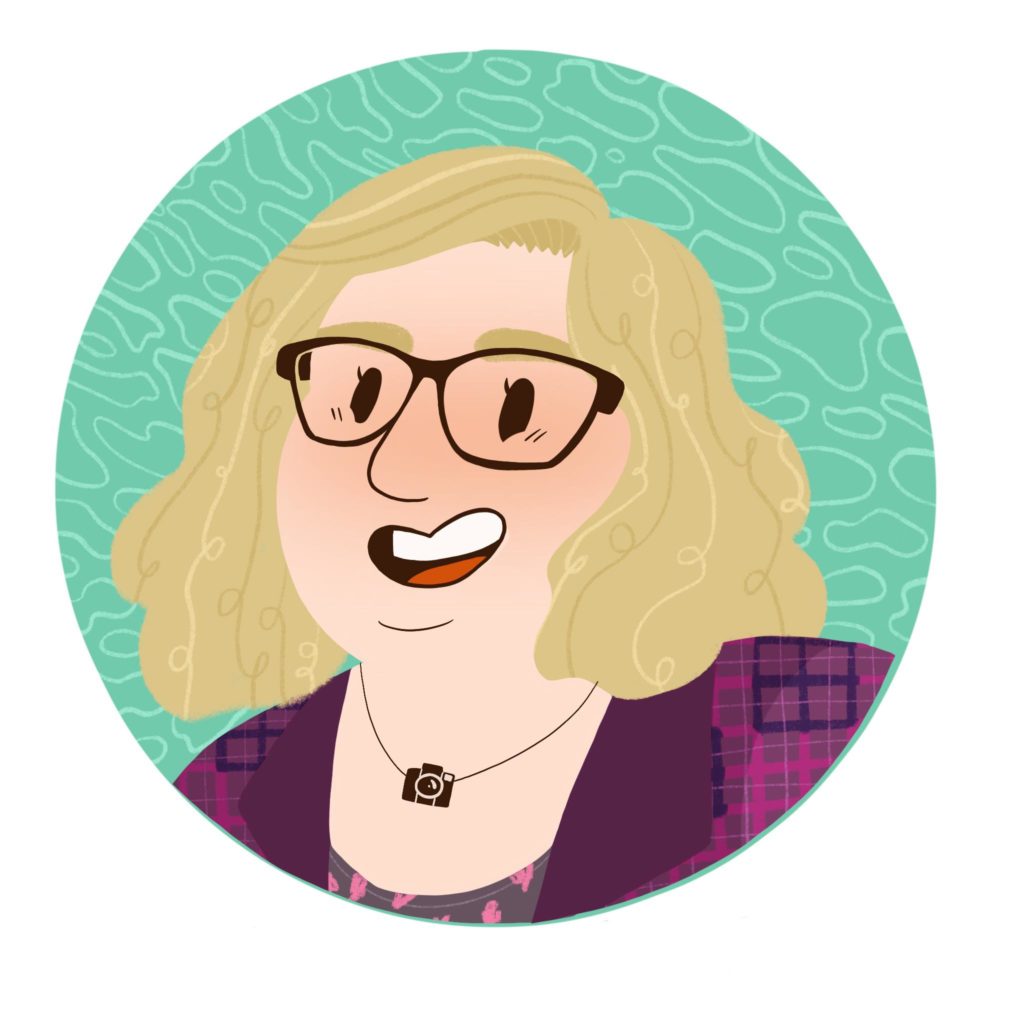
Every Monday, I send out my Body Liberation Guide, a thoughtful email jam-packed with resources on body liberation, weight stigma, body image and more. And it’s free. Let’s change the world together. Subscribe »
Jenn: Yes. It’s just thinking, I was like, oh, the stones of the water sounds really nice, but I’d love to see someone like a fat person, a plump personal, just to know, and you don’t even have to say it for me. You don’t have to say, hey, you don’t need a, hey, fatties welcome thing or a flashing light. But just seeing that picture, I will know you’ll take me seriously. And you won’t be sort of going to be insinuating in any way. Maybe if you lost weight, your life would improve. It’s like, oh God because I’m like fucking done with that. Like the whole weight loss, the magic cure of weight loss that cures all ills in life.
Lindley: Yes. It’s kind of a tangent but the thing is that too, we know from people who have gone from much larger bodies to much smaller bodies that you know, you’re still going to have the same life problems. You might have more privileges. You might fit in physically fit into more things. You might be treated better in general. But if you have anxiety, you’re still going to have anxiety. If you’re insecure, you’re still going to be insecure. But I want to skip back to the flashing sign fatties welcome. For the record, I would 100% be your client.
If you put a giant [unclear14:52] graphic that says fatties are welcomed. But I was talking to, trying to remember what business they were in. Maybe it was clothing, like someone who ran a small clothing boutique the other day and she said, I have on my website that I carry plus size, but I don’t ever have any plus-sized people come in and I don’t understand why. And I said, well, what kind of plus-sizing do you have? Do you carry up to, I’m using the United States sizing here for the record, but do you carry up to a size 12 or a size 26, a size 36? Like if I don’t know, I’m just less likely to come in. Because when we talk about marketing, we’re talking about those barriers.
We’re talking about those semi-conscious to subconscious things that pull people in or push them away. And photos are one of those things. But also I said, if you really want to attract plus size people be specific, what sizes do you carry? What’s the largest hip size that you carry? Go all out and say, my aisles are wide. And you know, are they again, United States thing, but are they ADA, the Americans with disabilities act accessible? Are they wheelchair accessible? Because when we talk about marketing and at least in the US, fat people are a significant portion of the population. So we’re like any other market that you might be trying to attract. And so putting these things on your website about that, you welcome people in larger bodies. That here’s how you have provided for those folks.
Here’s what you offer us. That’s not some tiny niche market. That’s like again in the US larger people are like two-thirds of the population. So it’s not like we are some incredible niche population that you just have to take extra steps [unclear17:00]. We’re everywhere, we make up a lot of the population. And so it makes sense to pull in that. But like any other niche market, if you specialized in sensory-friendly clothing and toys for people who are autistic. If you specialized in that, you would say so, and then you would say we, oh, and not only is our clothing sensory-friendly for folks with autism, but it’s great for everybody. So, including these things on your website is really helpful in addition to using diverse images, because if you are friendly to a specific population, say so. If you’re really proud of the fact that your clothing store, your boutique has aisles that are far enough apart for a wheelchair, then say, so, put it on your website because it’s great for SEO, if nothing else because if I’m looking for somewhere that carries a size 28, US apparel and I’m Googling Seattle size 28, I want your website to come up, I want to give you my money. Let me do it.
Jenn: That’s a good point. The SEO, I do want to see, yeah things come up. Like, I am inclusive. I am like all genders welcome. I recognize this. I want to see those things come up from a website, even like, I’d go back to coaches because we’re having push-pull here. These are my people [unclear18:56], let’s talk about this, but just that, just thinking about that, you know, when I see a coach that put diverse images up, you’re right, come out and say so, because I know I’m not going to get the same old, same old. Because me, if I go to a coach, who’s like, yeah, I accept there are not just two genders. I accept people will have different shapes and sizes and everyone’s deserving of respect. I believe this, I believe that put those beliefs out there. That’s going to make me want to work with you more than someone where I’m like, if I start saying anything left field about me, I know it’s fine. And it’s okay and it’s all going to work. It’s going to make me feel more comfortable even if that’s not directly related to me.
Jenn: You know, someone said, I don’t know, I’m just trying to think. Even if you put the rainbow flag up there and say, hey, you know, I’m for gay women. I’m not a gay woman, but I’m still like, okay if you’re for that, I’m going to be accepted as someone who’s like either slightly out there on the sexuality thing. And it’s like you accept that, you can accept me. Brilliant, hooray. I know I’m going to feel comfortable. So I suppose what I’m saying, he was even a tiny bit of diversity will go a long way because it’s like I know I’m just not going to get the same old, same old because I go and we talked about this just before the podcast. I was so fed up when people go, I want a pretty website, I want a pretty website.
It’s like, oh God, you know, it’s just going to be bland, boring and the same as everyone else. And especially, you know, my clients as well, they’re generally women or female-identifying people. Not always, you know, I don’t kind of like [unclear20:54] down on genitalia or anything like that, but getting back to the point, there are people who have overcome something in life. I’ve got people who’ve overcome alcoholism, come out of abusive relationships, and struggled with mental health and they come through it and I’m like, they’ve got a few battle scars and tend to be older as well. And they’re generally female older, there are lumps and bumps in places that weren’t before in their twenties and it’s like these lines. And so one of my clients says, look, send me a photo, oh, can you use the one where my face does a bit like an old bull sack, please? She was joking and laughing around. We were joking about wrinkles and everything. And it’s like, yeah, people who have come for these things are older. We’re not airbrushed, perfect. We’re not 22, we’re not even 42. And it’s like, we’ve got wrinkles and saggy jowls and things. And it’s like, what we’re selling here, what we’re doing, what we’re trading on. It’s not looks, it is so much more than our looks.
Lindley: Yeah. And we want our websites to be professional looking and good quality and have good images on them and be of an updated design. And this is what Jen does, but, but it’s also okay if we don’t worry too much about our websites being normative. And the thing is that my business is a little different because I photograph fat people and I’m an activist. So my body liberation work is front and center. You cannot escape it. When you go to my website at bodyliberationsphotos.com, the very first thing you see is a photo of a very fat woman in a bright red dress. So you cannot escape that. And that is part of what draws people to me is the fact that I do focus on a part of the population that doesn’t get a lot of attention.
And I would like to think that my website is relative, attractive, but I sort of got to a minimum level of pretty, and beyond that, I’m more concerned with, here’s what I offer very clearly. Here’s who I’m including, here’s who I’m encouraging, here’s who I want to work with, and is very clear about what I do and why. And again, coming back to SEO, if I put something on my website and particularly for women, for people who are in vulnerable populations, this can be tricky because there is a vulnerability in putting personal information on the internet, and there’s a vulnerability in being the one to stand up and say, I’m aging, and I like working with folks who are in their forties and fifties or whatever.
But again, not only are you showing in that example, I love coaching people in their forties and fifties who were starting to encounter body limitations because of aging. Just say that’s our example, and you’re a coach. It can feel very vulnerable to put that on your website because you’re having to tell the world that you are also struggling with these things that seem not normal, not normative, but again, not only are you helping normalize those things, but you are telling people whose welcome, and it’s good for SEO, and how many people are in their forties and fifties and struggling with that, that’s a huge population. So, I talk about changing the world with this stuff, and that’s a cool effect, but it’s good for your business too, because you are niching down, you are telling the world who you’ve worked with, and these are all market opportunities because we all are trying to do things that we love, but we also need to eat and pay bills.
And when I say I work with fat people, or you say, I work with people, I work with female-identified people in their 60s who are struggling with aging or whatever. These are market opportunities. And so when we focus on the pretty, when we focus on looking perfect in our own photos and perfect on our websites, and we don’t put any personal details or anything messy, because that doesn’t seem pretty or professional, we’re just not talking to anybody. We’re talking to the 22-year-old models in those photos that’s a very small population. Talking to everybody else, talking to the people like you and showing that, and being genuine and authentic in your marketing and on your website, like that’s a market opportunity. More people want people who get them.
Jenn: I want to just bottle everything you’ve said for the past couple of minutes because that was perfect. That was like, it was. It’s just like, say it, sing out. I won’t even try and paraphrase it, but it’s just the, yeah.
Lindley: With the internet, we don’t have to be Coca-Cola and sell to everybody. We don’t have to be… and the thing is that Coca-Cola already exists. They already have the market share. Our job is to feed ourselves and nourish ourselves. And the way we do that is to attract the niches. And the thing is that I keep saying in 22-year-old models, I don’t know what it is today, but 22-year-old models are also equally valuable people, but everybody is appealing to them, everyone is focusing on the lowest common denominator, like the widest possible, the most normative population, every clothing store wants the size 8 folks, but who is serving the size 28 folks?
Jenn: Oh my God, that brings me back to, I went into Dorothy Perkins here in the UK or Dotty P’s, well UK people will know Dotty P’s. And I tried to buy a top. It was a UK size 16 at the time. And I really wanted this top and I said to them, how come you have like loads of size 10s, 8s, 10s, and 12s, but very few 16s, 18s and so on. And they’re like, oh, we put those there for the teenagers, and I went, but they haven’t really got any money, but women in their 30s, 40s who would come into Dorothy Perkins and fifties maybe who were our size 14, 16, 18 have got money and they’re happy to spend it, but you do less of those sizes. I’m like, how does this make business sense? It’s like just teenagers in general. I remember being a young teenager, I’m thinking 14 to 20, those years, I didn’t have lots of spare cash to drop on clothes.
Lindley: Well, and the apparel industry, I could easily do a whole podcast on that. There are other forces at play than just who’s got money and is going to buy stuff. But you know, if you’re serving, again using US sizing, but if you’re serving size 28, that is a large number of people who aren’t being served elsewhere. And if they are, it’s an afterthought. So be the person that picks up the afterthoughts because there are how many billion people on this planet right now, even the afterthoughts are millions and millions of people. And the thing is that you’re probably one of those too in some way if nothing else, women are a marginalized population, of female-identifying people. So, if nothing else be honest about who you are and let that be reflected because for everything that you think is a flaw, for everything that you think is embarrassing or shameful, there will be a gazillion other people out there who will go, oh my God, that’s me too.
You know, the best performing post on my website ever, always is around blood pressure monitors for plus-size arms. I get 95% of my affiliate money from those links in that one article. And I have a whole affiliate webshop that has like, I don’t know, a thousand items in it, but what I make money from is that one article, because people are constantly searching for that. And it’s not, here are the five best blood pressure monitors. You know, it’s specifically here, the blood pressure monitors for fat people.
Jenn: Oh my God, we’ve wandered from photos to SEO. I’ve now got about three blog posts in my head [unclear30:31]. I also need to make a sign that says, fatties, welcome. I am going to, you understand wrap this up, but say again your website, like, say it in big letters, so everyone can go.
Lindley: In big letters, my website is at, bodyliberationsphotos.com and I’m very active on Instagram, more so than anywhere else. And you can get there @bodyliberationwithlindley. And yeah, I sent out a newsletter every week that has more, more content like this. It is called the Body Liberation Guide and you can get that on my website by going to bodyliberationsphotos.com and clicking more at the top, and it’s in the drop-down there. Or you can get there directly @bit.ly, that’s bit.ly/bodyliberationguide.
Jenn: Go there, go there.
Lindley: Happy to have you.
Jenn: We are going to finish up, I’m going to hit the finish recording button, and I’m going to try and do it like… I’ve got my phone here and I managed to like, stop this recording, like at the beginning of the podcast because like my [unclear31:51] fingers. So I’m going to hit the cord. I’m not very good at saying goodbye, so we’ll just both say goodbye.
Have a good one.
Hi there! I'm Lindley. I create artwork that celebrates the unique beauty of bodies that fall outside conventional "beauty" standards at Body Liberation Photography. I'm also the creator of Body Liberation Stock and the Body Love Shop, a curated central resource for body-friendly artwork and products. Find all my work here at bodyliberationphotos.com.

